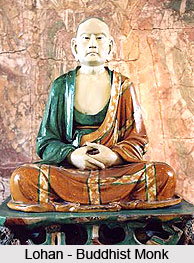 Lohan is the Chinese arahant. According to Theravada Buddhism a Lohan is one who follows the Noble Eight fold Path and has been successful in breaking away from the clutches of worldly pain and suffering. He is also liberated from the cycle of rebirth and karma. In China, Lohans are famous for their supernatural power, insight and bravery. They are also bestowed with the power to fight against evil powers. As a result they are considered the guardian angels of the Buddhist shrines.
Lohan is the Chinese arahant. According to Theravada Buddhism a Lohan is one who follows the Noble Eight fold Path and has been successful in breaking away from the clutches of worldly pain and suffering. He is also liberated from the cycle of rebirth and karma. In China, Lohans are famous for their supernatural power, insight and bravery. They are also bestowed with the power to fight against evil powers. As a result they are considered the guardian angels of the Buddhist shrines.
In Chinese Buddhist temples ,one would come across the Lohans standing in the main hall as protectors. It is said that there were initially 16 Lohans and around 500 lesser Lohans. Though there were originally 16 of them two were added during the Tang Dynasty. Hence today one will find 18 Lohan figures.
According to legends this portrait was painted in 891 AD by Guan Xiu, a Buddhist monk. The monk is said to be proficient in painting, poetry and calligraphy. Due to his expertise the Lohans chose him to draw this portrait. They appeared in his dream and entreated him to do the job.
There are several orders to which the Lohans belong. The order has been decided in accordance with which they are represented in the portrait. These orders are-Raised pagoda, Deer Sitting, Taming Tiger, Happy, Calico Bag, Elephant Riding, Raised Bowl, Meditating, Laughing Lion, Oversea, Open Heart, Doorman, Scratched Ear, Raised Hand, Plantain, Taming Dragon, Thinking and Long Eyebrow.
Such portraits, however, differ from dynasty to dynasty.









